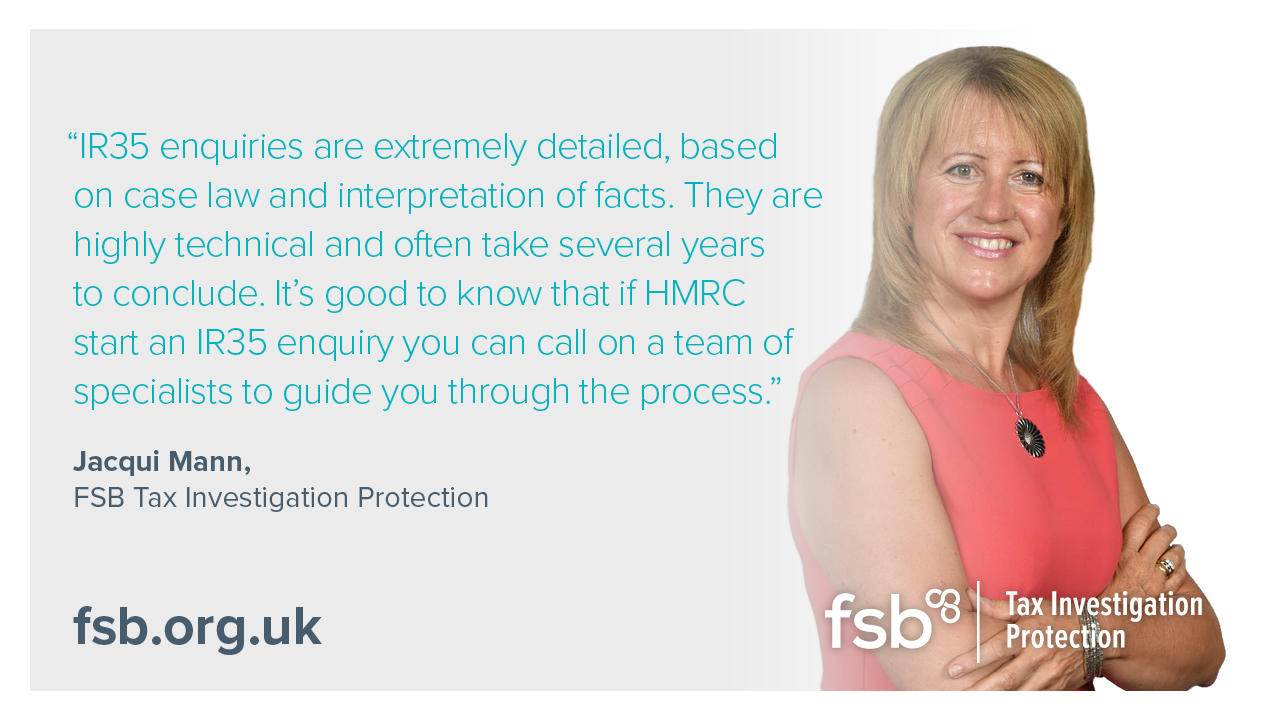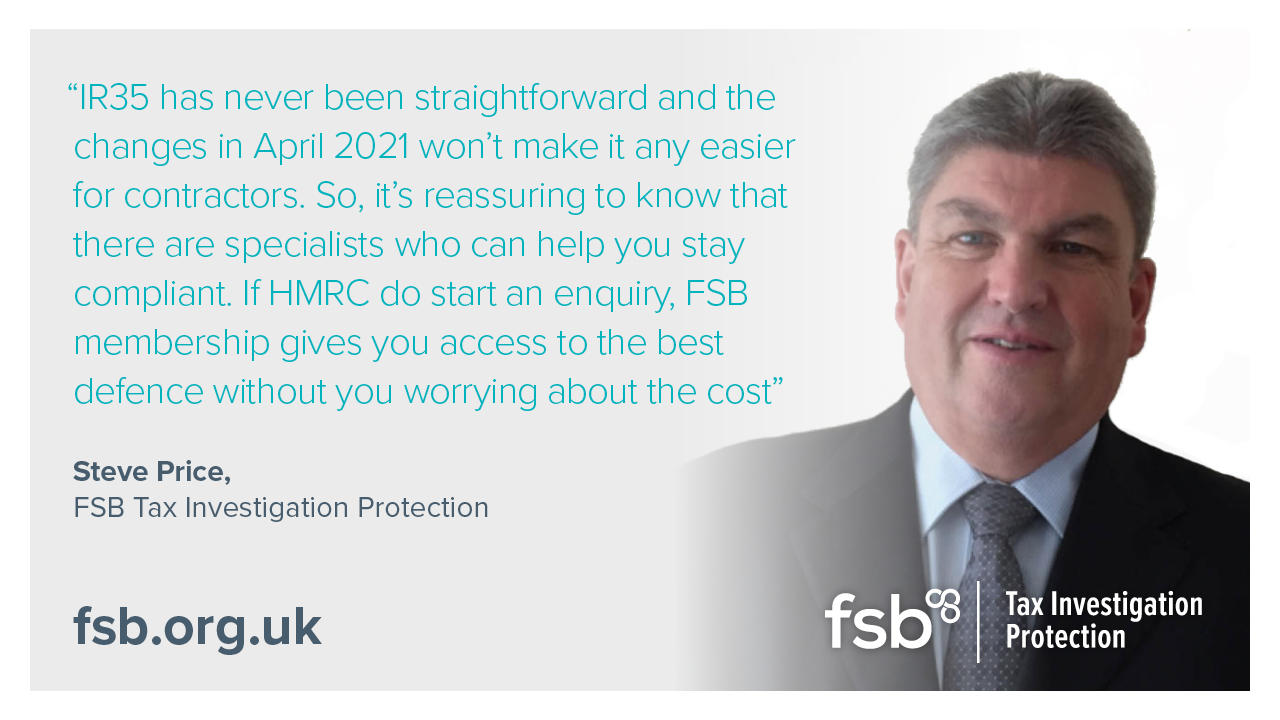
This content was last updated November 2022.
We’re here to help you understand the ins and outs of the off-payroll working changes introduced into the private sector 6 April 2021, so that you can stay compliant
What is IR35?
IR35, also known as the off-payroll working rules or intermediaries legislation. It was originally introduced in April 2000 to tackle what the Inland Revenue (now HMRC) perceived to be disguised employment. It was felt that many individuals trading through their own limited companies and engaged by end clients (your clients) were doing the same work as employees yet enjoying greater tax advantages.
It asks the question: if there was no limited company and the individual was working directly for the end client; would it look like employment (“inside IR35”)? Or self-employment (“outside” IR35)?
If the engagement is deemed to be inside IR35; i.e. considered to be akin to an employment relationship, those working through their own companies should pay the same income tax and National Insurance contributions as those who are employed directly.
What changed in the private sector?
Changes to IR35 legislation came into force on 6 April 2021, following a delay due to the coronavirus pandemic. The new rules have applied to services carried out from 6 April 2021. Although the September 2022 mini-budget announcement suggested that the reforms would be repealed in April 2023, it was only a few weeks later that this repeal was reversed and they remain very much part of the tax landscape.
Under the IR35 reform, the responsibility for determining your employment status rests with your client, where eligible. This was already the case for all businesses and workers in the public sector, where changes were introduced in 2017. However, the private sector reforms did introduce new requirements designed to improve transparency in IR35 decision-making which have also applied to the public sector since April 2021.
Who does IR35 apply to?
Off-payroll working rules apply if you provide services to a client through an intermediary (usually your own company; e.g. a personal service company), but would be classed as an employee for tax purposes if you were contracted directly.
If the rules apply and you’re deemed to be inside IR35, tax and National Insurance contributions must be deducted from your fees and paid to HMRC.
What’s the difference between inside IR35 and outside IR35?
IR35 applies on a contract by contract basis, so you may have some contracts that are inside IR35 and some that are outside IR35. Your status impacts the employment taxes you will pay. How and who pays the appropriate taxes depends upon a number of factors which are considered below and ensures that IR35 still remains a complex piece of legislation.
Inside IR35
In essence, you pay the same tax and National Insurance as you would if you were an employee. Your client will be required to pay the necessary tax and NIC, which includes Employers’ NIC and the apprenticeship Levy where applicable.
Outside IR35
Nothing changes. You are paid a flat fee as normal and are responsible for managing your own taxes.
Not sure whether your contract is inside or outside? You can check your employment status for tax using this tool from HMRC.
Who decides my IR35 status?
Responsibility for determining your status as inside or outside IR35 lies with medium and large-sized end clients in the private sector reforms and all public sector bodies under the legislation. This means the business using your services will be responsible for deciding your employment status.
Unfortunately, to make things more complicated, we have the concept of a “fee payer”, which is nothing more than the entity responsible for paying your company. If your company is engaged directly by the end client, then your client is both IR35-decsion-maker AND fee payer.
However, where there is a recruitment agency (or agencies) in the contractual chain, the end client is still the decision-maker, but the agency closest to your company become the fee payer. This means that if the engagement is deemed inside, it is their responsibility to deduct tax and National Insurance (and apprenticeship levy if applicable) from your hourly/daily rate and pay your company net.
If the engagement is deemed to be outside, then the fee payer will pay your company gross. But if HMRC can successfully argue that the engagement should have been treated as “inside”, and the end client can demonstrate that they took reasonable care in their decision-making, it is the fee payer agency which will be liable for the unpaid tax & NI.
As of 6 April 2021, you will no longer have had the responsibility for determining the IR35 status of an engagement unless you have been working with a small company in the private sector that meets two of the following three criteria and is therefore exempt from IR35 decision-making:
- An annual turnover of £10.2 million or less
- A balance sheet total less than £5.1 million
- Less than 50 employees
New rules apply to parent companies, so larger businesses won’t be able to set up smaller companies to avoid paying contributions where a freelancer is deemed inside IR35.
Please note that if you are engaged by a small company (or one based wholly overseas), the “old” IR35 rules apply and your company is responsible for determining IR35.
What affects my IR35 status?
The way your status is judged by your client - and HMRC - remains the same.
There are three key factors that determine employment status and if all are present then the relationship is one of employment. The three elements are used to assess whether your contract is for services (outside IR35) or of employment (inside IR35):
-
Control
Whilst how much control you have over where you work, what you do and when, as well as your client’s expectations of you are relevant, the key factor of control is whether you are ‘responsible for the performance of the services; i.e. how you do the work. If your contract demonstrates that you will be supervised or can be moved from task-to-task, this may indicate your engagement is inside IR35.
-
Mutuality of obligation
This is a commitment to offer and accept work. For example, when you show up to an office every day, you expect to be given tasks and your employer expects you to do them. Unlike with an employee, it can be more difficult to establish this relationship for a freelancer or contractor.
Your contract should be specific about the work that will be carried out in the project, and it should not imply any automatic renewals of your services, nor should there be any expectation that you will continue to be paid if no work is available.
-
Personal Service
Does your contract specify that your client only wants you? With a short-term freelance contract, you should be able to demonstrate that your personal service is not a requirement of the engagement and ideally you have a genuine right to send a substitute: someone else who could take your place to carry out the contracted work.
Technically, if one of these three factors is not present, the relationship cannot be one of employment; but most experts would say that to have a realistic prospect of winning your argument, you need to be able to demonstrate either a lack of personal service (e.g. you have a genuine right to send a substitute) or you can demonstrate that your client cannot exercise control over how you do your work.
It is important to remember that these contractual rights must be supported by the actual working arrangements.
In those cases where it is impossible to determine the status on the basis of the three key tests, then that is when you need to consider secondary factors like being in business on one’s own account and taking financial risk.
If you’re unsure about whether your contract will be considered inside or outside IR35, it’s advisable to speak to a legal expert.

What is a Status Determination Statement?
A Status Determination Statement (SDS) is a legal requirement of the legislation. It determines your employment status for tax purposes only following an IR35 assessment which the end client must undertake (and take reasonable care in doing so). Your client should have processes in place, not only to determine the IR35 status of each and every engagement, but also to deal with any challenge you might make if you disagree with that determination.
Your client must provide the SDS to you in writing with clear reasons why the status of the engagement has been determined as inside or outside of IR35. The SDS must be given to you as the individual, but if an agency or recruiter is involved (also known as the fee payer), the end client must provide them with the SDS which they must pass on to you.
Will the IR35 changes apply to my previous contracts?
HMRC have sought to reassure contractors that their focus is on ensuring that businesses comply with the reforms rather than focusing on historic cases; unless they have reason to suspect there is deliberate avoidance of employment taxes or fraud.
Therefore, it will not mean that HMRC will assume that a contractor being deemed to be in an inside IR35 engagement from April 2021 should have been treating their engagements as inside prior to that date. There are too many variables from the post-April contract being with a different end client (or with different terms) to changes in the nature of an existing engagement through to who is actually making the status determination for that assumption to be made (i.e. previously it would have been you, now it would be the end client).
My client says I’m inside IR35 but I don’t think I am, what should I do?
With the responsibility now with your client, there may be times when you disagree with their decision about your employment status.
The legislation gives you the right to submit a written challenge to the SDS and requires the end client to respond within 45 days to respond to further explain their reasoning.
Don’t panic. The first thing to do if you disagree is to seek advice from legal and tax experts before you begin any work. Our specialists will be able to guide you through the process of challenging the decision.
I’m dealing with an IR35 enquiry from HMRC, what can I do?
IR35 enquiries didn’t suddenly stop in April 2021 and certainly HMRC saw no reason to close enquiries that had commenced under the opld regime. There have been plenty of headline grabbing cases since the reforms came in, particularly in broadcasting.
Also, don’t forget that if your company is engaged by a small company or one based wholly overseas, you still retain the responsibility and liability for IR35. Therefore the risk of enquiry has not disappeared.
An IR35 enquiry can be daunting, especially when you’re managing it on your own. Employment status is a very technical, complex and grey area of tax and we strongly recommend that you seek professional advice. Whilst there’s no way of avoiding selection, you can prepare with our guide to tax investigations and what to expect.
Tax investigations can be stressful and time-consuming, which is why our members have access to professional advice and support from tax specialists through FSB Tax Investigation Protection.
More questions about IR35?
To learn more about IR35 legislation, FSB members have access to a detailed IR35 guide on the FSB Legal Hub.
Signing contracts is part of everyday life as a freelancer, but that doesn’t mean it should be stressful. Make more time for your next project with contract templates, IR35 support and a 24/7 legal advice line for all your questions.


